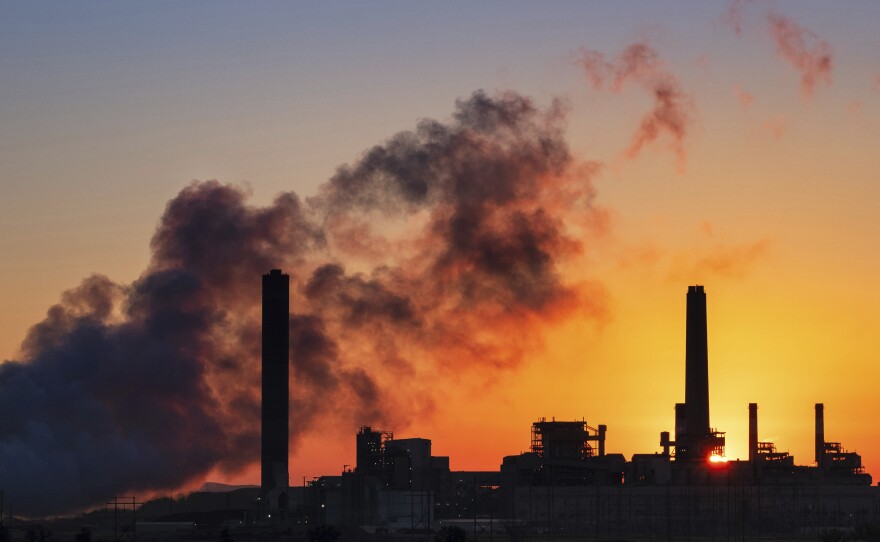The U.S. Supreme Court limited the power of the federal government to regulate greenhouse gas emissions from existing power plants. But its ruling didn't touch the power of the states.
That's putting a renewed focus on efforts across the country to limit the reliance on power plants that spew planet-warming emissions into the air. While Democratic states have taken the lead on the most aggressive climate policy in recent years, some Republican-led states are also helping shift the U.S. power grid toward cleaner sources of energy.
“This ruling makes clear that the actions of governors and state legislatures are more important than ever before. Thankfully, state authority to curb greenhouse gas emissions has not changed,” Democratic Govs. Jay Inslee of Washington, Kathy Hochul of New York and Gavin Newsom of California said in a statement after the ruling. The three are co-chairs of the U.S. Climate Alliance, a group of 24 states committed to climate action.
States can cut emissions from power plants in a handful of direct and indirect ways. Chief among them are carbon markets that aim to lower emissions from large, polluting facilities over time and rules that require utilities to buy certain amounts of energy from renewable or non-carbon sources.
California, New York and Washington are all known for setting some of the nation’s most ambitious climate goals. All three have committed to getting 100% of their electric power from non-carbon sources by 2040 or 2045. But they’re not alone. Eighteen states have set 100% clean energy goals, according to the U.S. Climate Alliance.
Most of the states in the alliance are led by Democrats, but a few including Vermont, Massachusetts and Maryland have Republican governors. Together the states account for 42% of the nation's greenhouse gas emissions.
So-called renewable portfolio standards don't directly regulate emissions. But they have a similar effect by encouraging utilities not to purchase power from carbon-emitting sources like coal-fired plants. They also encourage a ramp-up of solar, wind and other types of renewable power so that utilities will have enough places to buy energy as the rules tighten.
More than a dozen U.S. states also participate in some type of carbon market that more directly regulates emissions from power plants. Such markets set caps on the amount of allowable emissions, and polluters must buy allowances equal to what they want to emit.
The allowable emissions cap goes down over time, causing prices for the emissions allowances to go up. The goal is to encourage power plants and other polluters to reduce their emissions over time in a way that´s economically optimal for them and their customers.
California runs a cap-and-trade program that's a key part of the state's path to lowering emissions 40% below 1990 levels by 2030, though some critics question whether it can achieve that goal. On the East Coast, 11 states have partnered to created the Regional Greenhouse Gas Initiative, a similar market-based program designed to lower emissions.
“If the EPA doesn’t have this authority, then that certainly doesn’t preempt states from going ahead,” said Cary Coglianese, a law professor at the University of Pennsylvania focused on regulation.
But, he noted, the problem is that climate change is a global problem and mixed state efforts aren’t going to be enough to make real progress.
Indeed, the states that produce the most coal and natural gas are mostly led by Republicans, and they have a mixed record on advancing policies that support clean energy.
West Virginia, a heavy coal-producing state, brought the challenge against the EPA. In 2020, the state got 88% of its electricity from coal, with renewables like hydropower and wind accounting for just 6%. The Legislature in 2015 repealed a state law that required a certain amount of power to come from renewable or alternative sources.
Wyoming, West Virginia, Pennsylvania, Illinois and North Dakota produced the most coal among states in 2020, according to the U.S. Energy Information Administration. Texas, Pennsylvania, Louisiana, Oklahoma and West Virginia are the top producers of natural gas.
Texas, Pennsylvania and Oklahoma are among states that have set modest renewable goals for electric utilities, but they haven't been updated in recent years to set stricter goals for the future. Still, Texas produces the most wind energy in the nation by far and Oklahoma comes in third, according to the U.S. Energy Information Administration. That's largely driven by market forces and unlikely to change in light of the EPA's ruling.
Dan Farber, faculty director of the Center for Law, Energy & the Environment at the University of California, Berkeley, said market forces that are making coal a less economically viable energy source and lowering the cost of wind and solar will likely continue to shape states' energy choices regardless of political ideology.
“If you talk about climate change there are a lot of places where that conversation is going to go nowhere," he said. “But if you talk about renewable energy and modernizing the energy system, there are a lot of red states where that has some traction."





